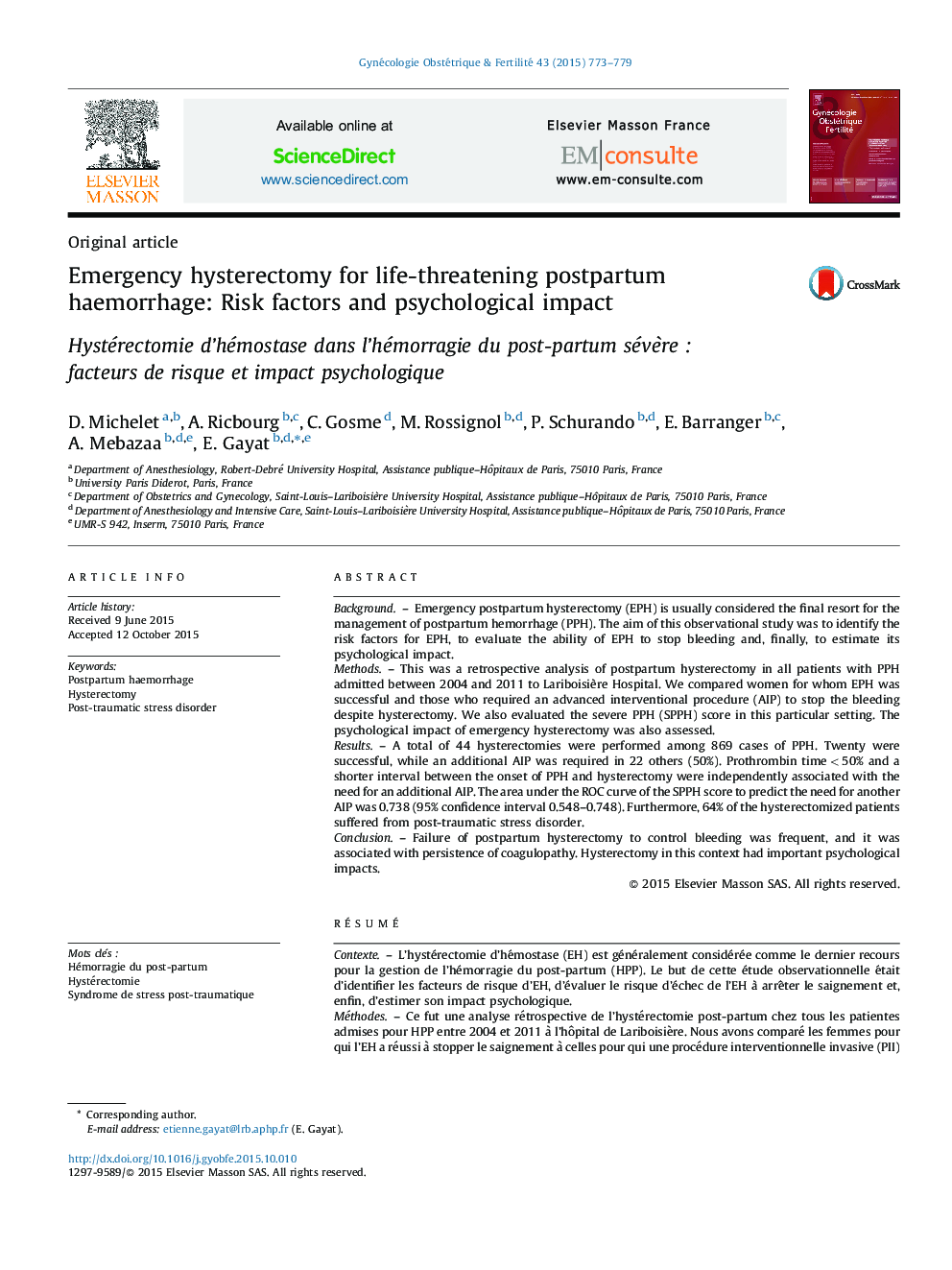| Article ID | Journal | Published Year | Pages | File Type |
|---|---|---|---|---|
| 3951198 | Gynécologie Obstétrique & Fertilité | 2015 | 7 Pages |
BackgroundEmergency postpartum hysterectomy (EPH) is usually considered the final resort for the management of postpartum hemorrhage (PPH). The aim of this observational study was to identify the risk factors for EPH, to evaluate the ability of EPH to stop bleeding and, finally, to estimate its psychological impact.MethodsThis was a retrospective analysis of postpartum hysterectomy in all patients with PPH admitted between 2004 and 2011 to Lariboisière Hospital. We compared women for whom EPH was successful and those who required an advanced interventional procedure (AIP) to stop the bleeding despite hysterectomy. We also evaluated the severe PPH (SPPH) score in this particular setting. The psychological impact of emergency hysterectomy was also assessed.ResultsA total of 44 hysterectomies were performed among 869 cases of PPH. Twenty were successful, while an additional AIP was required in 22 others (50%). Prothrombin time < 50% and a shorter interval between the onset of PPH and hysterectomy were independently associated with the need for an additional AIP. The area under the ROC curve of the SPPH score to predict the need for another AIP was 0.738 (95% confidence interval 0.548–0.748). Furthermore, 64% of the hysterectomized patients suffered from post-traumatic stress disorder.ConclusionFailure of postpartum hysterectomy to control bleeding was frequent, and it was associated with persistence of coagulopathy. Hysterectomy in this context had important psychological impacts.
RésuméContexteL’hystérectomie d’hémostase (EH) est généralement considérée comme le dernier recours pour la gestion de l’hémorragie du post-partum (HPP). Le but de cette étude observationnelle était d’identifier les facteurs de risque d’EH, d’évaluer le risque d’échec de l’EH à arrêter le saignement et, enfin, d’estimer son impact psychologique.MéthodesCe fut une analyse rétrospective de l’hystérectomie post-partum chez tous les patientes admises pour HPP entre 2004 et 2011 à l’hôpital de Lariboisière. Nous avons comparé les femmes pour qui l’EH a réussi à stopper le saignement à celles pour qui une procédure interventionnelle invasive (PII) supplémentaire a été nécessaire pour arrêter le saignement. Nous avons également évalué l’intérêt du score Severe Post-Partum Hemorrhage (SPPH) dans ce contexte particulier. L’impact psychologique de l’hystérectomie d’hémostase a également été évalué.RésultatsUn total de 44 hystérectomies ont été effectuées parmi 869 cas d’HPP. Vingt-deux ont réussi, alors qu’une PII supplémentaire a été nécessaire dans 22 autres (50 %). Le temps de prothrombine < 50 % et un intervalle plus court entre le début de l’HPP et l’hystérectomie étaient indépendamment associés à la nécessité d’une PII supplémentaire. L’aire sous la courbe ROC du score SPPH pour prédire la nécessité d’une autre PII était de 0,738 (intervalle de confiance à 95 % : 0,548 à 0,748). En outre, 64 % des patients ayant subi une hystérectomie ont souffert du syndrome de stress post-traumatique.ConclusionL’échec de l’hystérectomie d’hémostase pour contrôler le saignement est fréquent et semble associé à la persistance d’une coagulopathie. L’hystérectomie dans ce contexte a des répercussions psychologiques importantes.
